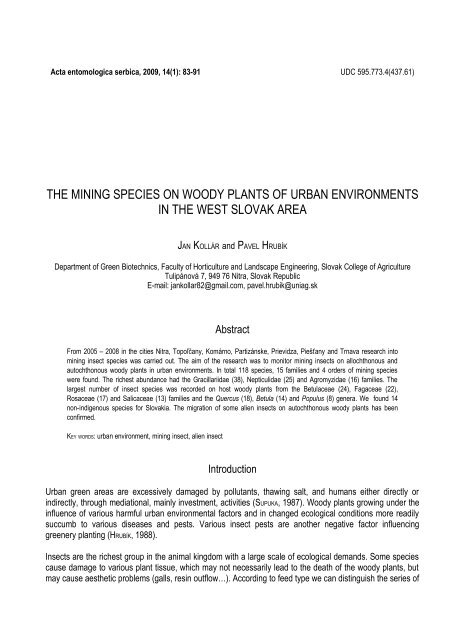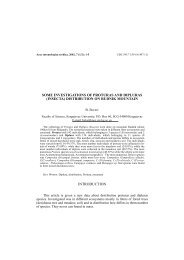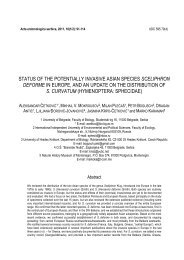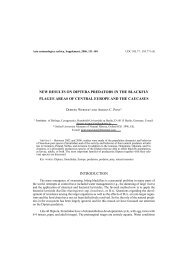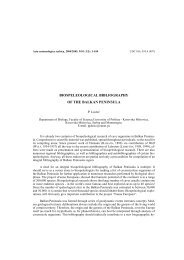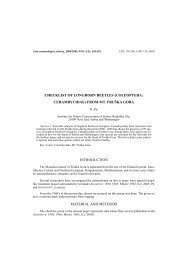Kollar, J. & Hrubik, P: The mining species
Kollar, J. & Hrubik, P: The mining species
Kollar, J. & Hrubik, P: The mining species
Create successful ePaper yourself
Turn your PDF publications into a flip-book with our unique Google optimized e-Paper software.
Acta entomologica serbica, 2009, 14(1): 83-91 UDC 595.773.4(437.61)<br />
THE MINING SPECIES ON WOODY PLANTS OF URBAN ENVIRONMENTS<br />
IN THE WEST SLOVAK AREA<br />
JAN KOLLÁR and PAVEL HRUBÍK<br />
Department of Green Biotechnics, Faculty of Horticulture and Landscape Engineering, Slovak College of Agriculture<br />
Tulipánová 7, 949 76 Nitra, Slovak Republic<br />
E-mail: jankollar82@gmail.com, pavel.hrubik@uniag.sk<br />
Abstract<br />
From 2005 – 2008 in the cities Nitra, Topoľčany, Komárno, Partizánske, Prievidza, Piešťany and Trnava research into<br />
<strong>mining</strong> insect <strong>species</strong> was carried out. <strong>The</strong> aim of the research was to monitor <strong>mining</strong> insects on allochthonous and<br />
autochthonous woody plants in urban environments. In total 118 <strong>species</strong>, 15 families and 4 orders of <strong>mining</strong> <strong>species</strong><br />
were found. <strong>The</strong> richest abundance had the Gracillariidae (38), Nepticulidae (25) and Agromyzidae (16) families. <strong>The</strong><br />
largest number of insect <strong>species</strong> was recorded on host woody plants from the Betulaceae (24), Fagaceae (22),<br />
Rosaceae (17) and Salicaceae (13) families and the Quercus (18), Betula (14) and Populus (8) genera. We found 14<br />
non-indigenous <strong>species</strong> for Slovakia. <strong>The</strong> migration of some alien insects on autochthonous woody plants has been<br />
confirmed.<br />
KEY WORDS: urban environment, <strong>mining</strong> insect, alien insect<br />
Introduction<br />
Urban green areas are excessively damaged by pollutants, thawing salt, and humans either directly or<br />
indirectly, through mediational, mainly investment, activities (SUPUKA, 1987). Woody plants growing under the<br />
influence of various harmful urban environmental factors and in changed ecological conditions more readily<br />
succumb to various diseases and pests. Various insect pests are another negative factor influencing<br />
greenery planting (HRUBÍK, 1988).<br />
Insects are the richest group in the animal kingdom with a large scale of ecological demands. Some <strong>species</strong><br />
cause damage to various plant tissue, which may not necessarily lead to the death of the woody plants, but<br />
may cause aesthetic problems (galls, resin outflow…). According to feed type we can distinguish the series of
84<br />
J. KOLLÁR & P. HRUBIK<br />
damage types as well. On woody plants which grow in non-forest environments, the most significant damage<br />
(surface feeds, mines, skeletation, deflection, distortion or gall forming, etc.) (GREGOROVÁ, 2006) is suffered by<br />
various leaves, buds, shoots and wood.<br />
In this paper we have dealt with insect pest groups which cause mines on leaves, shoots, and eventually on<br />
other parts of woody plant bodies. According to the record, the first mines made by lepidopterans appeared in<br />
late Jurassic, ca. 150 millions years ago. <strong>The</strong>ir number showed a steep increase in the Cretaceous, probably<br />
correlated with the radiation of angiosperms. In the last few decades leaf miners have become popular study<br />
organisms. Several ecological and evolutionary hypotheses have been tested on them, the attention spent on<br />
them exceeding their economical importance. <strong>The</strong> evolutionary success of leaf <strong>mining</strong> insects is proven by<br />
their large numbers, and by the fact that leaf <strong>mining</strong> <strong>species</strong> can be found in several orders. According to<br />
present knowledge, ca. 10,000 <strong>species</strong> of leaf <strong>mining</strong> insects have been described so far. <strong>The</strong>se insects<br />
belong to ca 50 families from 4 orders (Coleoptera, Hymenoptera, Diptera and Lepidoptera) (CSÓKA, 2003).<br />
STOLINA et al. (1985) defined <strong>mining</strong> as feeding inner tissues and needles, without damaging epidermis. Mines<br />
can be created by caterpillars, beetle larvae, hymenopteran and dipteran insects. Mines are always created<br />
only by insect larvae (STOLINA et al., 1985). Leaf mines vary considerably in shape and size, and can therefore<br />
be classified in many different ways. Mines can be serpentine and blotchy. Serpentine mines develop if<br />
larvae feed step by step in one direction. Blotchy mine forms if larvae turn during feeding (CSÓKA, 2003).<br />
Mining insects are the second most prevalent group of insects in urban greenery. If they don’t occur in large<br />
numbers, they don’t cause serious damage to host plants (HRUBÍK, 1988). WINIARSKA (1979) discovered that<br />
along with the composition of woody plants <strong>species</strong>, the number of <strong>mining</strong> lepidopteran <strong>species</strong> in the urban<br />
environment is changing in dependence on urbanization degree.<br />
Materials and Methods<br />
From 2005 – 2008 terrain research was carried out in the selected cities of Nitra, Topoľčany, Komárno,<br />
Partizánske, Prievidza, Piešťany and Trnava. <strong>The</strong> aim of the research was to monitor <strong>mining</strong> insects, mainly<br />
on ornamental woody plants planted in urban environments. In the terrain, woody plant damage was<br />
controlled visually and from 2005-2008 samples of symptoms were collected three times per vegetation<br />
period in all localities. Eventually, some samples were collected to be reared in the laboratory and for<br />
determination. Some <strong>species</strong> were determined directly in the terrain. For the determination of mine samples<br />
on individual woody plant <strong>species</strong> we used the publications by LAŠTŮVKA & LAŠTŮVKA (1997), CSÓKA (2003) and<br />
SCHNAIDER (1976). <strong>The</strong> correct woody plant nomenclature is passed from publications ČERVENKA (1986) and<br />
(MARHOLD-HINDÁK, 1998).<br />
Results<br />
During the research we found 118 <strong>species</strong> of <strong>mining</strong> insects, belonging to 4 orders and 15 families. <strong>The</strong><br />
greatest number of <strong>species</strong> belonged to the Gracillariidae (38), Nepticulidae (25) and Agromyzidae (16) (Fig.<br />
1a) families. Lepidoptera (91) and Diptera (16) (Fig. 1b) orders were the most abundant.<br />
<strong>The</strong> following review (Tab. I) presents the list of found <strong>mining</strong> <strong>species</strong>. Species are classified according to<br />
individual orders, families and host plants. <strong>The</strong> non-indigenous <strong>species</strong> are marked by an asterisk.
<strong>The</strong> <strong>mining</strong> <strong>species</strong> on woody plants of urban environments in western Slovakia 85<br />
Table I. List of recorded <strong>mining</strong> insects.<br />
Order Family Species/variety Host plant<br />
Lepidoptera Gracillariidae Parna tenella Klug., 1816 Tilia sp.<br />
Caloptilia betulicola (Hering, 1927) Betula verrucosa Ehrh.<br />
Caloptilia cuculipennella (Hübner, 1796) Fraxinus excelsior L.<br />
* Caloptilia roscipennella (HB., 1796) Acer pseudoplatanus L.,<br />
Juglans regia L.<br />
Xanthospilapteryx syringella (Fabr., 1794) Fraxinus sp., Ligustrum sp.,<br />
Syringa sp., Sambucus sp.<br />
Phyllonorycter acernella Zll., 1846 Acer sp.<br />
Phyllonorycter acerifoliella Z., 1839 Acer pseudoplatanus L., A. tataricum L.<br />
Phyllonorycter platanoidella Joan., 1920 Acer sp.<br />
Phyllonorycter ulmifoliella (Hbn., 1817) Ulmus sp., Betula sp.<br />
Phyllonorycter agilella Z. 1846 Ulmus sp.<br />
* Phyllonorycter platani Staudinger, 1870 Platanus occidentalis L.,<br />
P. x acerifolia (Ait.) Willd.<br />
Phyllonorycter froelichiella Zll. 1839 Alnus glutinosa (L.)<br />
Phyllonorycter tenerella Joan., 1915 Carpinus betulus L.<br />
Phyllonorycter apparella H.S., 1855 Populus alba L., Populus nigra L.<br />
Phyllonorycter spinicolella Z., 1846 Prunus cerasifera Ehrh., P. avium L., P. spinosa L.<br />
Phyllonorycter lautella Zll., 1846 Quercus sp.<br />
Phyllonorycter salictella Zll., 1846 Salix alba L.<br />
Phyllonorycter nicellii Stt., 1851 Corylus colurna L.<br />
Phyllonorycter pastorella Zll., 1846 Salix alba L.<br />
* Phyllonorycter robiniellus Clemens, 1859 Robinia sp.<br />
Phyllonorycter quinnata Geoffr., 1851 Carpinus betulus L.<br />
Phyllonorycter cerasicolella (Herrich-Schäffer, 1855) Prunus avium L., P. serrulata Lindl., P. subhirtella<br />
Miq.<br />
Phyllonorycter schreberella (Fabricius, 1781) Ulmus sp.<br />
Phyllonorycter heegeriella (Zeller, 1846) Quercus sp.<br />
Phyllonorycter quercifoliella (Zeller, 1839) Quercus robur L., Quercus x turneri Willd.<br />
'Pseudoturneri'<br />
Phyllonorycter comparella (Duponchel, 1843) Populus alba L.<br />
Phyllonorycter trifasciella (Haworth, 1828) Lonicera fragrantissima L., Symphoricarpos albus L.<br />
Phyllonorycter tristrigella (Haworth, 1828) Ulmus minor Mill.<br />
Phyllonorycter coryli (Nicelli, 1851) Corylus colurna L., Sorbus aria (L.) Crantz<br />
Phyllonorycter maestingella Zeller, 1764 Fagus sylvatica L.<br />
Phyllonorycter roboris Zeller, 1839 Quercus sp.<br />
* Phyllonorycter issikii Kumata, 1963 Tilia sp.<br />
* Phyllonorycter leucographellus (Zeller, 1850) Pyracantha coccinea Roem.<br />
* Parectopa robiniella Clemens, 1863 Robinia pseudoacacia L.<br />
* Cameraria ohridella (Deschka & Dimic, 1986) Aesculus hippocastanum L.<br />
Acrocercops brongniardella Fbr., 1798 Quercus cerris L.<br />
Parornix finitimella Zll., 1850 Prunus cerasifera Ehrh., Prunus avium L.<br />
Parornix anglicella Stt., 1850 Crataegus monogyna Jacq.
86<br />
J. KOLLÁR & P. HRUBIK<br />
Order Family Species/variety Host plant<br />
Lepidoptera Bucculatricidae Bucculatrix frangulella (Goeze, 1783) Rhamnus catharticus L.<br />
Bucculatrix thoracella (Thunberg, 1794) Tilia sp.<br />
Alucitidae Alucita hexadactyla (Linnaeus, 1758) Lonicera xylosteum L.<br />
Heliozelidae Antispila metallella (Denis & Schiffermüller, 1775) Swida sanguinea (L.) Opiz<br />
Antispila treitschkiella (Fischer von Röslerstamm,<br />
1843)<br />
Cornus mas L.<br />
Phyllocnistidae Phyllocnistis unipunctella Steph., 1834 Populus alba L., P. nigra L.<br />
Phyllocnistis xenia Hering, 1936 Populus sp.<br />
Phyllocnistis saligna Z., 1839 Salix alba L.<br />
Phyllocnistis suffusella Zll., 1848 Populus x canescens Smith<br />
Yponomeutidae * Argyresthia thujella (Packard, 1871) Thuja occidentalis L.<br />
(Table I - continued)<br />
* Argyresthia trifasciata Staudinger, 1871 Juniperus sp., Cupressocyparis x leylandii Dall.<br />
Prays fraxinella (Bjerkander, 1784) Fraxinus excelsior L.<br />
Lyonetiidae Lyonetia clerkella (L., 1758) Betula sp., Prunus sp., Malus sp., Crataegus sp.,<br />
Sorbus intermedia (Ehrh.)<br />
Leucoptera scitella (Zeller, 1839) Prunus avium L., P. subhirtella<br />
Coleophoridae Coleophora fuscedinella Zeller, 1849 Betula verrucosa Ehrh.<br />
Coleophora palliatella Zincken, 1813 Quercus robur L.<br />
Coleophora serratella (Linnaeus, 1761) Betula verrucosa Ehrh.<br />
Coleophora ibipennella Zeller, 1849 Quercus robur L.<br />
Coleophora flavipennella Duponchel, 1843 Quercus robur L.<br />
Coleophora lutipennella (Zeller, 1838) Quercus robur L.<br />
* Coleophora hemorobiella Scop., 1763 Spiraea x vanhottei (Briot) Zab., S. japonica L. f.<br />
Tortricidae * Coleotechnites piceaella (Kft., 1903) Picea pungens Engelm., P. omorica (Pančić)<br />
Purkyně<br />
Epinotia tedella (Cl., 1759) Picea abies (L.) Karst., Picea pungens Engelm.<br />
Epinotia rufimitrana H. S., 1851 Abies alba Mill.<br />
Nepticulidae Stigmella speciosa (Frey, 1858) Acer sp.<br />
Stigmella confusella WOOD., 1894 Betula sp.<br />
Stigmella microtheriella Stainton, 1854 Corylus colurna L.<br />
Stigmella nivenburgensis (Preissecker, 1942) Salix alba L.<br />
Stigmella hahniella (Wörtz, 1890) Sorbus torminalis (L.) Crantz<br />
Stigmella luteella (Stainton, 1857) Betula verrucosa Ehrh., Betula pubescens Ehrh.<br />
Stigmella lemniscella (Zeller, 1839) Ulmus glabra Huds., Ulmus minor Mill.<br />
Stigmella szoecsiella (Borkowski, 1972) Quercus cerris L.<br />
Stigmella atricapitella Haw., 1828 Quercus sp.<br />
Stigmella betulicola (Stainton, 1856) Betula verrucosa Ehrh., B. maximowicziana Regel<br />
Stigmella prunetorum (Stainton, 1855) Prunus avium L.<br />
Stigmella salicis (Stainton, 1854) Salix alba L.<br />
Stigmella crataegella (Klimesch, 1936) Crataegus monogyna Jacq., Crataegus laevigata<br />
(Poir.) DC
<strong>The</strong> <strong>mining</strong> <strong>species</strong> on woody plants of urban environments in western Slovakia 87<br />
Order Family Species/variety Host plant<br />
Lepidoptera Nepticulidae Stigmella argentipedella Z., 1839 Betula verrucosa Ehrh.<br />
Stigmella carpinella Hein., 1862 Carpinus betulus L.<br />
Stigmella hemargyrella Koll., 1832 Fagus sylvatica L.<br />
Stigmella subtrimaculella Dufr., 1949 Populus sp.<br />
Stigmella tityrella (Stainton, 1854) Quercus sp.<br />
Stigmella centifoliella Zll., 1848 Rosa sp.<br />
Stigmella ulmifoliae Htg., 1931 Ulmus sp.<br />
Stigmella plagicolella S.H., 1854 Prunus cerasifera Ehrh., Malus sp.<br />
Stigmella tiliae Frey., 1856 Tilia sp.<br />
* Acalyptris platani (Müller-Rutz, 1934) Platanus x acerifolia (Ait.) Willd.<br />
Ectoedemia cerris (Zimmermann, 1944) Quercus cerris L.<br />
Ectoedemia occultella (L., 1767) Betula verrucosa Ehrh.<br />
(Table I - continued)<br />
Tischeriidae Tischeria ekebladella Bjk., 1795 Quercus sp.(Q. rubra L.), Castanea sativa Mill.,<br />
Castanea millissima Blume<br />
Tischeria decidua Wck., 1876 Quercus sp.<br />
Tischeria dodonea (Stainton, 1858) Quercus robur L.<br />
Coptotriche angusticollella (Duponchel, 1843) Rosa canina L.<br />
Coleoptera Buprestidae Trachys minutus (Linnaeus, 1758) Tilia platyphyllos Scop.<br />
Curculionidae Rhynchaenus jota F., 1787 Alnus glutinosa (L.)<br />
Rhynchaenus fagi L., 1758 Fagus sylvatica L.<br />
Rhynchaenus alni L., 1758 Alnus glutinosa (L.)<br />
Rhynchaenus quercus (L., 1758) Quercus robur L.<br />
Hymenoptera Tenthredinidae Profenusa pygmaea (Klug, 1816) Quercus cerris L., Q. robur L., Q. aliena Blume,<br />
Q. rubra L.<br />
Heterarthrus aceris (Kaltenbach, 1856) Acer pseudoplatanus L.<br />
Heterarthrus vagans (Fallén, 1808) Betula verrucosa Ehrh.<br />
Messa nana (Klug, 1814) Betula verrucosa Ehrh.<br />
Scolioneura betulae Zdd., 1858 Betula verrucosa Ehrh.<br />
Scolineura nigricans (Klug, 1818) Betula verrucosa Ehrh.<br />
Diptera Agromyzidae Liriomyza amoena MQ., 1830 Sambucus nigra L.<br />
Agromyza albitarsis MG., 1830 Populus tremula L., P. nigra L.<br />
Agromyza alnibetulae Hend., 1931 Alnus glutinosa (L.)<br />
* Amauromyza elaeagni (Rohdendorf-Holmanová,<br />
1959)<br />
Elaeagnus angustifolia L.<br />
Napomyza xylostei Kltb., 1862 Lonicera sp., Symphoricarpos sp.<br />
Amauromyza verbasci (Bouche, 1847) Buddleja globosa Hope<br />
Phytomyza periclymeni Hend., 1922 Lonicera sp.<br />
Phytomyza agromyzina Meigen, 1830 Cornus sp., Swida sp.<br />
Phytomyza atricornis Meigen, 1838 Laburnum anagyroides Med.<br />
* Agromyza demeijerei Hendel, 1920 Laburnum anagyroides Med.<br />
Paraphytomyza xylostei R.D., 1851 Lonicera xylosteum L., L. tatarica L.
88<br />
J. KOLLÁR & P. HRUBIK<br />
Order Family Species/variety Host plant<br />
Diptera Agromyzidae Aulagromyza heringii (Hendel 1920) Fraxinus excelsior L.<br />
(Table I - continued)<br />
Aulagromyza cornigera (Griffiths, 1973) Lonicera xylosteum L., Symphoricarpos albus (L.)<br />
Blake<br />
Chromatomyia lonicerae (Robineau-Desvoidy, 1851) Lonicera xylosteum L.<br />
Liriomyza congesta (Becker, 1903) Colutea arborescens L.<br />
Aulagromyza populicola (Haliday, 1853) Populus nigra L.<br />
Recorded <strong>species</strong> feed on 40 genera and 18 families of host woody plants. <strong>The</strong> most <strong>mining</strong> <strong>species</strong> were<br />
recorded on the genera Quercus (18), Betula (14) and Populus (8) (Fig. 2a). Within woody plant families the<br />
highest number of <strong>mining</strong> insect <strong>species</strong> were recorded in the Betulaceae (24), Fagaceae (22), Rosaceae<br />
(17) and Salicaceae (13) families (Fig. 2b).<br />
a b<br />
Figure 1. Proportion of found insect <strong>species</strong> according to families (a) and orders (b) [families: 1 – Gracillariidae (32%), 2<br />
– Phyllocnistidae (3%), 3 – Coleophoridae (6%), 4 – Nepticulidae (21%), 5 – Tischeridae (3%), 6 – Yponomeutidae<br />
(3%), 7 – Tortricidae (3%), 8 – Curculionidae (3%), 9 – Tenthredinidae (5%), 10 – Agromyzidae (14%) and 11 – other<br />
(7%); orders: 1 – Lepidoptera (77%), 2 – Coleoptera (4%), 3 – Hymenoptera (5%) and 4 – Diptera (14%)].<br />
During the research we focused also on alien <strong>mining</strong> insect <strong>species</strong> and recorded in total 14 alien <strong>species</strong>.<br />
From this number the most abundant <strong>species</strong> come from the Mediterranean area [Phyllonorycter platani<br />
Staudinger, 1870; Acalyptris platani (Müller-Rutz, 1934); Agromyza demeijerei Hendel, 1920; Amauromyza<br />
elaeagni (Rohdendorf-Holmanová, 1959); Argyresthia trifasciata Staudinger, 1871; Cameraria ohridella<br />
(Deschka & Dimic, 1986)]. From North America four <strong>species</strong> [Phyllonorycter robiniellus Clemens, 1859;<br />
Parectopa robiniella Clemens, 1863; Coleotechnites piceaella (Kearfott, 1903) and Argyresthia thujella<br />
(Packard, 1871)] were brought to the Slovak area; from Asia three <strong>species</strong> [Phyllonorycter issikii Kumata,<br />
1963; Caloptilia roscipennella (Hübner, 1796) and Phyllonorycter leucographellus (Zeller, 1850)]; and the
<strong>The</strong> <strong>mining</strong> <strong>species</strong> on woody plants of urban environments in western Slovakia 89<br />
origin of one <strong>species</strong> is unknown [Coleophora hemorobiella Scop., 1763]. Some of these <strong>species</strong> occur not<br />
only on host plants from countries of their origin, but they also traverse to autochthonous woody plant <strong>species</strong><br />
[for example, there are: Coleotechnites piceaella (Kearfott, 1903); Phyllonorycter issikii Kumata, 1963;<br />
Caloptilia roscipennella (Hübner 1796) and Phyllonorycter leucographellus (Zeller, 1850)]. We have recorded<br />
the occurrence of the Horse chestnut leaf miner Cameraria ohridella (Deschka & Dimic, 1986) on<br />
autochthonous Field Maple Acer campestre L.. HRUBÍK (2007) dealt with alien <strong>species</strong> in Slovakia in his<br />
publication too.<br />
a b<br />
Figure 2. Proportion of found host plant genera (a) and families (b) [genera: 1 – Tilia (4%), 2 – Betula (11%), 3 –<br />
Fraxinus (3%), 4 – Acer (5%), 5 – Ulmus (5%), 6 – Alnus (3%), 7 – Carpinus (2%), 8 – Populus (6%), 9 - Prunus (5%),<br />
10 – Quercus (14%), 11 – Salix (4%), 12 – Corylus (2%), 13 – Lonicera (5%), 14 – Symphoricarpos (2%), 15 – Sorbus<br />
(2%), 16 – Fagus (2%), 17 – Crataegus (2%), 18 – Cornus (2%) and 19 – other (20%); families: 1 – Rosaceae (13%),<br />
2 – Fagaceae (17%), 3 - Betulaceae(%), 4 – Salicaceae (10%), 5 – Sapindaceae (5%), 6 – Caprifoliaceae (9%), 7 –<br />
Oleaceae (5%), 8 – Fabaceae (4%), 9 – Cupressaceae (2%), 10 – Cornaceae (2%), 11 – Ulmaceae (5%), 12 –<br />
Tiliaceae (4%) and 13 – other (6%)].<br />
Conclusions and Discussion<br />
In 2008 we recorded some occurrences of a decrease in <strong>mining</strong> <strong>species</strong> on woody plants, not only in urban<br />
environments but in forest crops as well. <strong>The</strong>ir abundance began to increase until the end of August and in<br />
September a phenomenon which could have been caused by an oscillation (amplitude) in temperature during<br />
the vegetation period. During the research we did not find more damage to woody plants. More marked<br />
damage was caused by <strong>species</strong> as Cameraria ohridella (Deschka & Dimic, 1986); Phyllonorycter platani<br />
Staudinger, 1870; Coleotechnites piceaella (Kearfott, 1903) and Epinotia tedella (Clerck, 1759). From 2002 –<br />
2004 ŠEFROVÁ (2005) carried out research into <strong>mining</strong> lepidopteran <strong>species</strong> in the Czech Republic area of the<br />
Arboretum of Mendel University of Agriculture and Forestry in Brno. Her results show that the most abundant<br />
were <strong>species</strong> from the Nepticulidae (41%) and Gracillariidae (36%) families. Our findings are very similar: the<br />
most numerous <strong>species</strong> were from the same families, but from Gracillariidae, 32% and Nepticulidae, 21%. In<br />
terms of host plants, the <strong>mining</strong> <strong>species</strong> are fixed on the Betulaceae (18%), Fagaceae (17%) and Rosaceae<br />
(13%) families. Comparison of these results with data from ŠEFROVÁ (2005) – Rosaceae (28%), Fagaceae
90<br />
J. KOLLÁR & P. HRUBIK<br />
(17%), Betulaceae (14%), shows the abundance of the most numerous families is the same, but again in<br />
opposed sequence. <strong>The</strong>se anomalies can be caused by a variability in the examined assortment of woody<br />
plants which depend on the biodiversity in individual research areas. We also analyzed all orders of <strong>mining</strong><br />
<strong>species</strong>, not only Lepidoptera, as ŠEFROVÁ (2005) did. In the last years we recorded a high increase of a nonindigenous<br />
termophilic <strong>species</strong> number from the Mediterranean. This higher migration of Mediterranean<br />
<strong>species</strong> to our area can be a result of global warming.<br />
References<br />
CSÓKA, G., 2003. Leaf mines and leaf miners. Agroinform kiadó, Budapest, 192 pp.<br />
ČERVENKA, M., ČINČURA, F., JASIČOVÁ, M. & ZÁBORSKÝ, J., 1986. Slovak botanical nomenclature. Príroda, Bratislava, 520 pp. [in<br />
Slovak]<br />
GREGOROVÁ, B., ČERNÝ, K., HOLUB, V., STRNADOVÁ, V., ROM, J., ŠUMPICH, J. & KLOUDOVÁ, K. 2006. Woody plants damage and its<br />
reasons. ZO ČSOP, Praha, 504 pp. [in Czech]<br />
HRUBÍK, P., 1988. Animal pests of urban greenery. Veda, Bratislava, 196 pp. [in Slovak]<br />
HRUBÍK, P., 2007. Alien insect pests on introduced woody plants in Slovakia. Acta entomologica serbica, 12(1): 81–85.<br />
LAŠTŮVKA, A. & LAŠTŮVKA, Z., 1997. Nepticulidae Mitteleuropas. Ein illustrierter Begleiter (Lepidoptera). Konvoj, Brno, 230<br />
pp.<br />
MARHOLD, K. & HINDÁK, F., 1998. Checklist of non-vascular and vascular plants of Slovakia. Veda, Bratislava, 688 pp. [in<br />
Slovak]<br />
SCHNAIDER, Z., 1976. Atlas of trees and shrubs damages caused by insects and spiders. Państwowe wydawnictwo<br />
naukowe, Warszawa, 320 pp. [in Polish]<br />
STOLINA, M., ČAPEK, M., GOGOLA, E., HEŠKOVÁ, A., KODRÍK, J., KŘÍSTEK, J., KUDELA, M., NOVÁČEK, M., SLÁDEK, J., VANÍK, K, GADEK,<br />
K., KIELCZEWSKI, B., LUTEREK, R., SIERPIŃSKI, Z., SZMIDT, A., BENCZE, L., IGMANDY, Z. & CANKOV, G., 1985. Forest<br />
protection. Príroda, Bratislava, 437 pp. [in Slovak]<br />
SUPUKA, J., 1987. Regulations for greenery and assessment of trees in settlements. Veda, Bratislava, 179 pp. [in Slovak]<br />
ŠEFROVÁ, H., 2005. Mining Lepidoptera of woody plants in the Arboretum of Mendel University of Agriculture and Forestry<br />
in Brno - <strong>species</strong> composition, origin and their influence on the health condition of plants. Acta universitatis<br />
agriculturae silviculturae Mendelianae brunensis. MZLU, 53(2): 133–142. [in Czech]<br />
WINIARSKA, G., 1979. Community structure of <strong>mining</strong> butterflies on lindens and oaks leaves in various types of urban<br />
greenery. In: Warunki drzew i ich fauny w Warszawie. Wyd. PAN, pp. 84-87. [in Polish]
<strong>The</strong> <strong>mining</strong> <strong>species</strong> on woody plants of urban environments in western Slovakia 91<br />
ИНСЕКТИ МИНЕРИ НА ДРВЕНАСТИМ БИЉКАМА<br />
У УРБАНИМ СРЕДИНАМА ЗАПАДНЕ СЛОВАЧКЕ<br />
ЈАН КОЛАР И ПАВЕЛ ХРУБИК<br />
Извод<br />
У периоду од 2005. до 2008. године на шест локалитета у Словачкој истраживани су минери<br />
дрвенастих биљака. Циљ рада је био мониторинг минера на алохтоним и аутохтоним врстама<br />
дрвенастих биљака у урбаним срединама. Утврђено је 118 врста минера, које су класификоване у 15<br />
фамилија и 4 реда. Најбројније фамилије су Gracillariidae (38), Nepticulidae (25) и Agromyzidae (16).<br />
Највећи број врста уловљен је на биљкама из фамилија Betulaceae (24), Fagaceae (22), Rosaceae (17)<br />
и Salicaceae (13); затим на родовима Quercus (18), Betula (14), Populus (8). Утврђено је 14 унесених<br />
врста за Словачку. Потврђене су миграције неких интродукованих врста у аутохтоне шумске<br />
заједнице, односнo биљке.<br />
Received March 23rd, 2009<br />
Accepted May 27th, 2009


